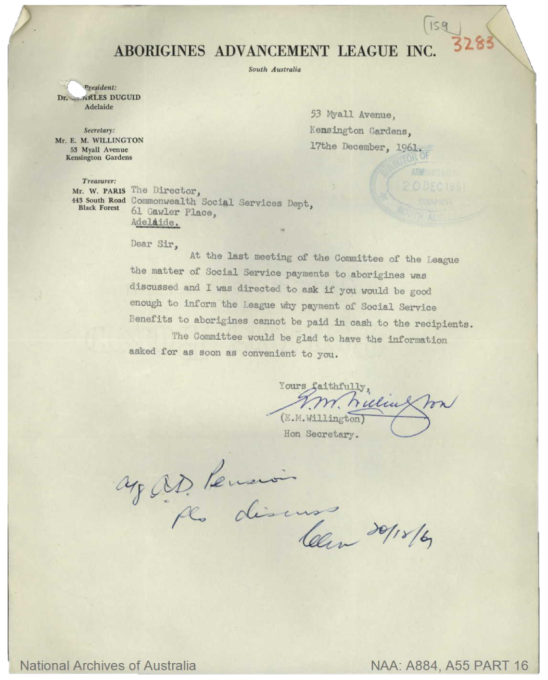
Request for direct payments in South Australia results in change
Activist EM Willington successfully petitioned the government for direct payments for Aboriginal people who had earned an independent income, paid taxes and managed their money their whole lives.
We should like, however, to urge the special case for cash payment of benefits to the people on the two South Australian Government Reserves at Point Pearce and Point McLeay.
| Attachment | Size |
|---|---|
| willington-letters.pdf | 1.89 MB |
| Attachment | Size |
|---|---|
| willington-letters-plaintext.docx | 49.23 KB |
For many years, most Aboriginal people living on state government missions and reserves weren’t eligible for direct payments. The government paid property managers a bulk amount and they decided how to use the money on behalf of residents.
These letters from EM Willington, honorary secretary of the South Australian Aborigines Advancement League (SA AAL), asked for a change to this rule. Willington requested direct payments for Aboriginal residents at Point Pearce and Point McLeay reserves.
When the Department of Social Services (DSS) passed on the letters, the South Australian Aborigines Protection Board increased the direct payment amount.
Query about payment methods
Willington first asked DSS ‘why payment of Social Service benefits to Aborigines cannot be paid in cash to the recipients’ in late 1961.
In response to Willington’s letter, Director-General of DSS, HJ Goodes, said the ‘guiding principle is that, wherever possible, payment should be made to the individual concerned’.
Despite this principle, people weren’t getting paid directly.
Another request for direct payments
Willington wrote to DSS again in early 1962, urging the department to implement direct payments for Aboriginal pensioners at Point Pearce and Point McLeay reserves as a ‘special case’.
Willington argued that residents in these communities were used to handling their own money as they were able to earn income off the reserve. They said it was ‘humiliating’ for people to have less control of their own money once they applied for a payment.
Goodes replied and said that state authorities were responsible for Aboriginal affairs. The letters were forwarded to South Australian authorities, including the Aborigines Protection Board.
Response from South Australian authorities
In May 1962, the Aborigines Protection Board said they would change the method of payment at Point Pearce and Point McLeay. They asked DSS to prepare to pay individual people their payments directly.
DSS officials agreed to implement the request. They noted the ‘Board’s change of attitude is … “exciting” news’. DSS also agreed to pay Child Endowment to pension recipients at these reserves, raising the total amount of money people would get.
Access to payments a long-standing and ongoing concern
Concern about the control of South Australian authorities over Aboriginal people’s government payments had existed for some time. Residents of Point Pearce and Point McLeay had written to the government about being eligible for payments as early as 1947.
SA AAL had been gathering information about indirect payment practices and presented their findings to the Federal Council for the Advancement of Aborigines and Torres Strait Islanders (FCAATSI) at a conference in 1961. The Minister for Social Services, Hugh Roberton, was questioned about the issue in the House of Representatives in 1960 and again in 1961.
In this case, advocacy for Point Pearce and Point McLeay residents had a favourable outcome. However, it took years for direct payments to be made to Aboriginal and Torres Strait Islander people living elsewhere.
The Aboriginal Advancement League of South Australia (SA AAL) was founded in 1951 by Dr Charles Duguid, a non-Indigenous Aboriginal rights advocate. The SA AAL was aligned with the Federal Council for Aboriginal Advancement (FCAA), later FCAATSI.
These letters sent by the SA AAL were kept on a file by the Department of Social Services. The file was later transferred to the National Archives of Australia, which holds it as part of the national archival collection. Only correspondence which referred to DSS policy is included in this excerpt.
You can view these files through RecordSearch. Go to pages 17–20 of Part 16, then go to pages 181, 186–187, 193, 267 and 270 of Part 17.
Citation
National Archives of Australia: Department of Social Services; A884, Correspondence files, 1951–1974; A55 Part 16, Aborigines – Eligibility for social service benefits – Policy file, 1961–1962.
National Archives of Australia: Department of Social Services; A884, Correspondence files, 1951–1974; A55 Part 17, Aborigines – Eligibility for social service benefits – Policy file, 1961–1962.
